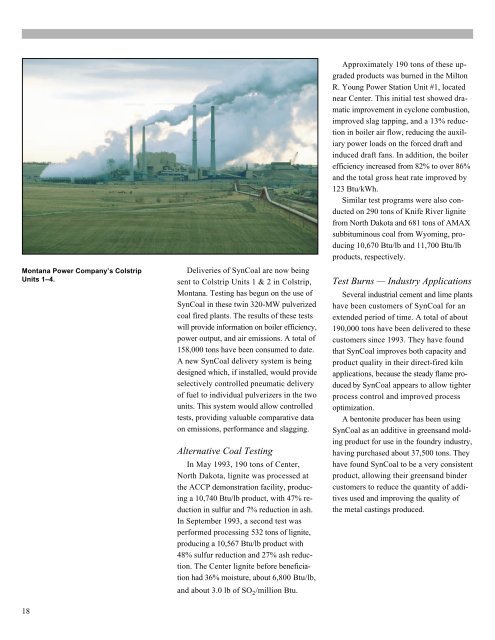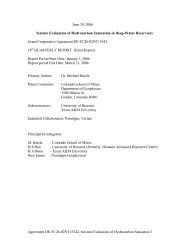Upgrading of Low-Rank Coals - National Energy Technology ...
Upgrading of Low-Rank Coals - National Energy Technology ...
Upgrading of Low-Rank Coals - National Energy Technology ...
You also want an ePaper? Increase the reach of your titles
YUMPU automatically turns print PDFs into web optimized ePapers that Google loves.
Montana Power Company’s Colstrip<br />
Units 1–4.<br />
18<br />
Deliveries <strong>of</strong> SynCoal are now being<br />
sent to Colstrip Units 1 & 2 in Colstrip,<br />
Montana. Testing has begun on the use <strong>of</strong><br />
SynCoal in these twin 320-MW pulverized<br />
coal fired plants. The results <strong>of</strong> these tests<br />
will provide information on boiler efficiency,<br />
power output, and air emissions. A total <strong>of</strong><br />
158,000 tons have been consumed to date.<br />
A new SynCoal delivery system is being<br />
designed which, if installed, would provide<br />
selectively controlled pneumatic delivery<br />
<strong>of</strong> fuel to individual pulverizers in the two<br />
units. This system would allow controlled<br />
tests, providing valuable comparative data<br />
on emissions, performance and slagging.<br />
Alternative Coal Testing<br />
In May 1993, 190 tons <strong>of</strong> Center,<br />
North Dakota, lignite was processed at<br />
the ACCP demonstration facility, producing<br />
a 10,740 Btu/lb product, with 47% reduction<br />
in sulfur and 7% reduction in ash.<br />
In September 1993, a second test was<br />
performed processing 532 tons <strong>of</strong> lignite,<br />
producing a 10,567 Btu/lb product with<br />
48% sulfur reduction and 27% ash reduction.<br />
The Center lignite before beneficiation<br />
had 36% moisture, about 6,800 Btu/lb,<br />
and about 3.0 lb <strong>of</strong> SO2 /million Btu.<br />
Approximately 190 tons <strong>of</strong> these upgraded<br />
products was burned in the Milton<br />
R. Young Power Station Unit #1, located<br />
near Center. This initial test showed dramatic<br />
improvement in cyclone combustion,<br />
improved slag tapping, and a 13% reduction<br />
in boiler air flow, reducing the auxiliary<br />
power loads on the forced draft and<br />
induced draft fans. In addition, the boiler<br />
efficiency increased from 82% to over 86%<br />
and the total gross heat rate improved by<br />
123 Btu/kWh.<br />
Similar test programs were also conducted<br />
on 290 tons <strong>of</strong> Knife River lignite<br />
from North Dakota and 681 tons <strong>of</strong> AMAX<br />
subbituminous coal from Wyoming, producing<br />
10,670 Btu/lb and 11,700 Btu/lb<br />
products, respectively.<br />
Test Burns — Industry Applications<br />
Several industrial cement and lime plants<br />
have been customers <strong>of</strong> SynCoal for an<br />
extended period <strong>of</strong> time. A total <strong>of</strong> about<br />
190,000 tons have been delivered to these<br />
customers since 1993. They have found<br />
that SynCoal improves both capacity and<br />
product quality in their direct-fired kiln<br />
applications, because the steady flame produced<br />
by SynCoal appears to allow tighter<br />
process control and improved process<br />
optimization.<br />
A bentonite producer has been using<br />
SynCoal as an additive in greensand molding<br />
product for use in the foundry industry,<br />
having purchased about 37,500 tons. They<br />
have found SynCoal to be a very consistent<br />
product, allowing their greensand binder<br />
customers to reduce the quantity <strong>of</strong> additives<br />
used and improving the quality <strong>of</strong><br />
the metal castings produced.

















